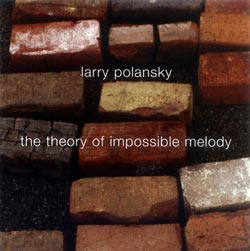
For those not familiar with Larry Polansky, The Theory of Impossible Melody, a collection that includes highlights of his many focuses since the mid 1970's, serves as an excellent primer for the composer's music.
On "(B'rey'sheet) (in the beginning...) (Cantillation Study #1)" (1985), Polansky incorporates text from the Torah (sung by composer, performer and Polansky's wife, Jody Diamond) with "live interactive computer". As the voice recites, the software interprets and outputs a set of rules to determine intervals and tuning, creating an intriguing series of intricate textural shadows that eventually unwind into a series of suspensions and sustained notes during the final section of the piece. "Epitaph (Four Voice Canon #21) (tmfg)" (1975) is a conversation between the composer's improvisations on fretless electric guitar (each voice in a different tuning) versus his MEAP software, all wrapped in a mensuration canon (a technique where each subsequent voice uses an augmented or degraded rhythmic duration and all end simultaneously). As per the tradition of this form, each subsequent sound file inspires increased, bristling tension via serialized panning, pitch, length and "spectral stability" until the argument finishes in a hard-right squeak. The 23-minute highlight of the disc, "Simple Actions/Rules of Compatibility" (1989), is a bi-formal work that merges an HMSL performance (software Polansky designed as a live A.I. style tool, one that morphs simple musical gestures into sophisticated musical forms) with a digitally enhanced narration by Australian poet, Chris Mann. The result is an FM synth-driven cacophony of glassy beeps, bubbling glisses and LFO sirens elided by Mann's tongue-twisting phrases at the 11:33 mark. Polansky uses Mann's voice as source material, "one of the (simple) musical 'actions'", which he feeds into HMSL, the program quickly morphing the artist's prose into a nervous sidecar of glitches, staccato screeches and legato bass tones. The disc's coda, "Psaltery" (1978-9), is, on paper, an incredibly complicated fifty-one pitch-based work for the one-string instrument of the same name. However, despite the complexity of the extra-musical processes (the graph in the liner notes is a head spinner), the system is transparent and the piece emanates elegance, beauty and a meditative aesthetic in the vein of Ellen Fullman's long-stringed instrument performances.
During a master class, Polansky once said, "Every composer has one, maybe two great ideas during his lifetime", but as evidenced on this album, Polansky has made a career of taking numerous intriguing yet difficult ideas and making them extraordinary. For example, he may not have invented the mensuration canon, but his three decades of dedication (see "Four-Voice Canons") earns him near-ownership of the genre. Likewise, Polansky's fervor for and exploration of Gamelan, computer-assisted composition, microtonal scales and just intonation translates into a mastery few possess on one of these subjects let alone all of them.
Comments and Feedback:



More Recent Reviews, Articles, and Interviews @ The Squid's Ear...


|

